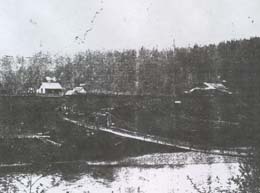In 1896, citizens near present-day Jordan in Snohomish County build a suspension bridge over the South Fork of the Stillaguamish River. Its purpose is to connect the homesteads along the river to each other and to get the children to the school on the east side of the river. A few years later, the bridge will be widened to support light vehicles, horses, and cattle. After the expansion of the Jordan Valley Mine in 1922, it will continue to provide an adventurous way across the river to residents of the area. Today, a new more solid suspension bridge has replaced it. It is located on Jordon Road about six miles southeast of Arlington.
A Bridge on the Mighty South Fork of the Stilly
The South Fork of the Stillaguamish flows past gravelly river bars and steep banks. In the spring it rages and over eons it has changed its course. In the late 1880s, the future community of Jordan was a heavily forested wilderness with an overland byway marked only by axe markers. Its main thoroughfare was the Stilly, the canoe the only mode of travel. Once homesteaders made claims and began to log off their land for farming, the push for a school began. To get the pupils to school, they needed a safer way to get across the wide water. They also needed to transport supplies and collect the mail.
Elias Holmstad (1837-1927) was one of the early Jordan homesteaders. A few years after his arrival in 1888, he constructed a wire footbridge on his claim down near the bend in the river. His sons and community members on both sides of the river came together and helped. There are no descriptions of this bridge, but the wire was possibly the type of cable used by miners for traversing gorges and rivers with “go devils,” a primitive transport. The bridge was narrow, perhaps four to five feet wide, with plank floor hung with “wire.” It was used for a number of years before being swept away by a bursting logjam.
A few years later, Ole Eliason, one of Holmstad’s sons, constructed a second bridge. It was placed at its present site upriver from his father’s claim and following the advice from the county engineer, set much higher above the water. It took several months of hard, grueling work to produce a bridge withstanding all tests.
In 1906, S. G. Buell, Snohomish County commissioner, helped the settlers widen the bridge to support the weight of light vehicles, cattle, and horses. Around 1918, a coal mine was developed on the south side of the river near the bridge. As Jordan Valley Coal expanded its tunnels, the need for strengthening the bridge’s structure became obvious.
“The suspension bridge at Jorden is being rebuilt and strengthened so as to have a capacity of ten tons and to permit of its use by wagons and trucks. This is being accomplished by constructing a crib pier near the center of the present span which is being further, strengthened by the addition of an extra suspension cable on either side, making six in all. The span also will be widened two feet to a width of eight feet and the floor will be hung by iron rods instead of wire as at present (Arlington Times, June 25, 1924).
The bridge was widened and continued to be used by locals long after the mine closed. Sometimes that was in peril. School children used the bridge to get to the school bus and local farmers drove their tractors across. Bill Lundberg, grandson of Ole Eliason, recalls that when he was a boy in the 1930s, a girl fell through and ended up in the water. Another time, a family member got his tractor stuck.
Demolition Plans and New Beginnings
In 1972, the county threatened to demolish the bridge because no one owned it and no one would accept responsibility for its maintenance. At the time, only locals used it, including three students who took the bus to their school in Arlington. After much discussion, the bridge was condemned in November of the same year.
Some time later, a new swinging style bridge was put up in the 1970s, but by 1985 the bridge was in bad shape. It had a deck made of timber planks and rails. Chicken wire was set between the deck and the rail made of logging cable. Both the planks and the tower, also made of timber, were rotting.
The bridge was closed in the 1990s for repairs and opened during that decade in its present form under the jurisdiction of the Snohomish County Parks. The beautiful semi-solid today structure spans both history and one of the loveliest branches of the Stillaguamish. It offers a gateway to the community on the other side of the river and a great place to fish and picnic.

